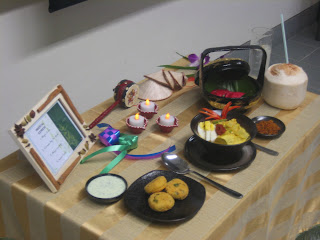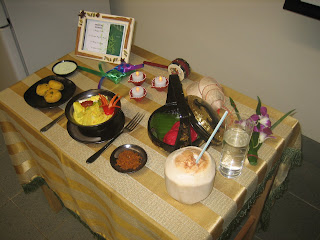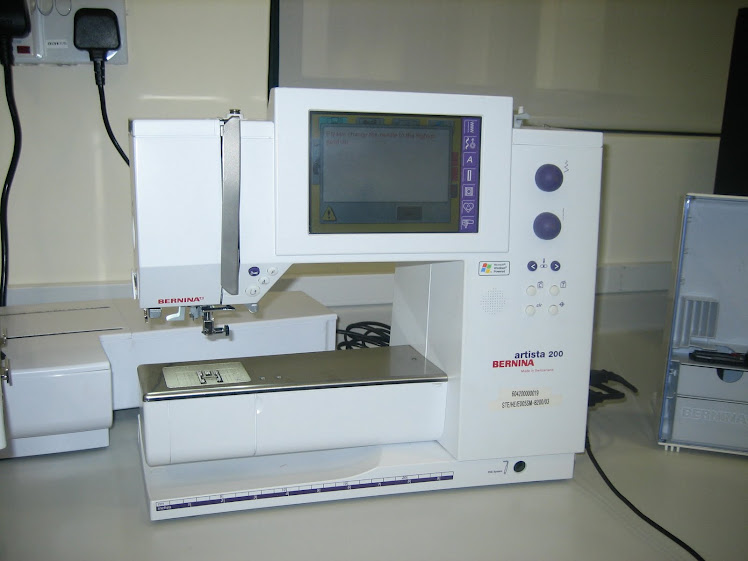JAY CAN SEW AND COOK FOR YOU!!!
Tuesday, January 15, 2013
Sunday, January 23, 2011
Sunday, November 14, 2010
Group 6 Ethnic fusion Bombardier






The 13 ingredient paste

This is the breakfast item that is widely eaten by many and loved.

Coriander chutney.....
Much similar to the Mint(puthina) and 'Thuvayal'.
Coconut chutney is the standard.

Vadai....
I have the habit of eating this snack and thosai's as well as biryani's when I visit 'Tekka' area.
After which, I would buy sweet meats and then head back home.
:0

The menu card. Sorry for the blurred image. :)

This picture is outstanding....
It shares a similarity with group 1's microteaching(The group I was in):0.
It is about multi-ethnicity.
What we did several weeks back were on food that was eaten globally.
Couscous was what Mavi and myself had decided.
Couscous was introduced by my brother-in-law back in 2007.
It tastes like 'chappati' and 'poori' but in a granular form.
In group 6's context, All members made foods that were consumed locally.
Malay, Chinese and Indian food.
This is a typical scenario for teaching National Education in Home Economics.
We are all so diverse yet so much similar in our thoughts,deeds and emotions.
:0

Absa's fabulous lontong. I have eaten much of this but never really cared to find out that there were 13 different ingredients in the paste itself.....
AMAZING!!!
:0

Ang Ku kuih.....I remember a joke made by a friend of mine about a decade ago that came back to memory. It was about his girl friend blushing. :)

Food that I am very familiar with.There are many variations to this. I love prawns on it.

The norm of a mass debrief
Sunday, November 7, 2010
Group 5 Food fare
Tuesday, November 2, 2010
ICT .....may want to incorporate homec
https://docs.google.com/document/edit?id=1hkSOb0Ely1ViJli2EsvSDR3Gwg
Sunday, October 31, 2010
Group 4 Food Galore!!!
Friday, October 29, 2010
http://www.essortment.com/all/amazingfoodfac_rcqm.htm
1. Butter and margarine are similar in calories. Many people say "No thanks" to butter in favor of margarine, which they think has fewer calories. In fact, unless they choose diet margarine, it probably has approximately the same number of calories per tablespoon as butter. The difference is that butter is higher in saturated fats, while margarine generally has more unsaturated fats. But calorie counts may be close. Check the label to be sure!
2. There are peanuts in many candies, even non-peanut candy-coated chocolates. People who are allergic to peanuts must be very careful because this is the most dangerous of all food allergies. Accidentally eating a peanut or peanut products could cause a severe reaction in an allergic person, even death. Therefore, it is important to read labels of all foods, even those that do not obviously contain peanuts. Many chocolate candies may be contaiminated with peanuts during production (while peanut candies are being made in the same factory) and they will carry this warning on the label.

3. Low-fat foods can be fattening. It is a misconception that low-fat foods are low calorie. They may be lower in fat and calories than their counterparts, but the difference may be slim. And sometimes the fat content is not that much less than regular "full fat" foods. Again, check the label and compare low-fat foods to their regular counterparts. If you are counting calories, low-fat calories count just as much as any calories.
4. Refrigerated foods aren't always safe. The key is safe storage at all times, including refrigerated storage. For example, if you are storing ground beef wrapped in butcher paper, it is important that the paper be placed in a pan so that it does not drip on other refrigerated foods. If hamburger juice drips on to raw foods, the latter can become contaiminated with such bacteria as E. Coli.

5. Cookie dough is a tasty, but dangerous, treat. While it may taste better than the finished product, it carries some risk. If the dough contains eggs, it could contain such bacteria as salmonella and should not be eaten. Remember to bake first, eat later!


6. Phosphorus may be depleting your bones of calcium. Many researchers believe that the body keeps phosphorus and calcium in balance in the bloodstream. The problem arises when the blood levels of phosphorus get too high. To stay in balance, the body pulls calcium out of bones and into the bloodstream. The result is lower levels of calcium in the bones, which could contribute to osteoporosis. Phosphorus is found in carbonated beverages, so it is believed that too many of these drinks can lead to osteoporosis.

7. Fruit juices are often high in calorie. While fruit juices are flavorful and sometimes packed with vitamins, they are also packed with calories. Fruit is a source of sugar and juices are no exception. It's great to drink some fruit juice, but check the label for calorie counts. Next time you're pouring your third glass of juice in a row, you may want to consider a switch to no-cal water.
8. Grapefruit juice has chemicals in it, which can cause harmful side effects if taken with certain medications. If you are taking medications on a regular basis and if you drink grapefruit juice or eat grapefruit regularly, check with your doctor or pharmacist to see if you are at risk.
9. Hamburgers may be juicy when they are still pink in the center, but they are much safer to eat when all the pink has disappeared, and the juices are clear. The pink indicates a level of rawness in the meat, meaning harmful bacteria such as E.Coli may still be present. While E. Coli generally lives only on the surface of solid meats, it can be distributed throughout ground meats.
10. Breakfast is still the most important meal of the day. Many dieters falsely believe that by skipping breakfast they are saving calories. What usually happens is that the body makes up for the lack of food later in the day. This is a double problem because the later you eat, the less time you have for working off calories. Wake up and eat at least a light breakfast, rather than no breakfast. Your body may thank you by being less hungry later in the day.
There is a lot to learn about foods, and as newfangled foods become available, there are even more facts to know. Thank goodness for great labeling!
2. There are peanuts in many candies, even non-peanut candy-coated chocolates. People who are allergic to peanuts must be very careful because this is the most dangerous of all food allergies. Accidentally eating a peanut or peanut products could cause a severe reaction in an allergic person, even death. Therefore, it is important to read labels of all foods, even those that do not obviously contain peanuts. Many chocolate candies may be contaiminated with peanuts during production (while peanut candies are being made in the same factory) and they will carry this warning on the label.
3. Low-fat foods can be fattening. It is a misconception that low-fat foods are low calorie. They may be lower in fat and calories than their counterparts, but the difference may be slim. And sometimes the fat content is not that much less than regular "full fat" foods. Again, check the label and compare low-fat foods to their regular counterparts. If you are counting calories, low-fat calories count just as much as any calories.
4. Refrigerated foods aren't always safe. The key is safe storage at all times, including refrigerated storage. For example, if you are storing ground beef wrapped in butcher paper, it is important that the paper be placed in a pan so that it does not drip on other refrigerated foods. If hamburger juice drips on to raw foods, the latter can become contaiminated with such bacteria as E. Coli.
5. Cookie dough is a tasty, but dangerous, treat. While it may taste better than the finished product, it carries some risk. If the dough contains eggs, it could contain such bacteria as salmonella and should not be eaten. Remember to bake first, eat later!
6. Phosphorus may be depleting your bones of calcium. Many researchers believe that the body keeps phosphorus and calcium in balance in the bloodstream. The problem arises when the blood levels of phosphorus get too high. To stay in balance, the body pulls calcium out of bones and into the bloodstream. The result is lower levels of calcium in the bones, which could contribute to osteoporosis. Phosphorus is found in carbonated beverages, so it is believed that too many of these drinks can lead to osteoporosis.
7. Fruit juices are often high in calorie. While fruit juices are flavorful and sometimes packed with vitamins, they are also packed with calories. Fruit is a source of sugar and juices are no exception. It's great to drink some fruit juice, but check the label for calorie counts. Next time you're pouring your third glass of juice in a row, you may want to consider a switch to no-cal water.
8. Grapefruit juice has chemicals in it, which can cause harmful side effects if taken with certain medications. If you are taking medications on a regular basis and if you drink grapefruit juice or eat grapefruit regularly, check with your doctor or pharmacist to see if you are at risk.
9. Hamburgers may be juicy when they are still pink in the center, but they are much safer to eat when all the pink has disappeared, and the juices are clear. The pink indicates a level of rawness in the meat, meaning harmful bacteria such as E.Coli may still be present. While E. Coli generally lives only on the surface of solid meats, it can be distributed throughout ground meats.
10. Breakfast is still the most important meal of the day. Many dieters falsely believe that by skipping breakfast they are saving calories. What usually happens is that the body makes up for the lack of food later in the day. This is a double problem because the later you eat, the less time you have for working off calories. Wake up and eat at least a light breakfast, rather than no breakfast. Your body may thank you by being less hungry later in the day.
There is a lot to learn about foods, and as newfangled foods become available, there are even more facts to know. Thank goodness for great labeling!
Subscribe to:
Comments (Atom)
Meal planner
BERNINA













